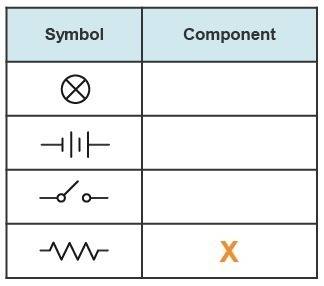
Physics, 30.09.2019 00:30 cupcake3103670
Patty makes a table of the symbols used for the parts of an electric circuit. what label should patty place in the marked cell? battery switch resistor bulb

Answers: 2
Another question on Physics

Physics, 21.06.2019 17:30
The ballistic pendulum was invented in 1742 by english mathematician benjamin robins. it consists of an initially stationary pendulum that moves after being struck by a bullet, and it is used to measure the original velocity of the bullet. the known variables are the bullet's mass m, the pendulum's mass m, and the height to which the block and bullet swing, determined by the length of the pendulum l and final angle θ. two principles of physics are necessary to solve for the bullet's original velocity. what are these principles? conservation of momentum and newton's third law conservation of energy and conservation of angular momentum grade summary deductions 0% potential 100% conservation of momentum and newton's second law. newton's second law and conservation of angular momentum. conservation of energy and newton's third law conservation of momentum and conservation of angular momentum. conservation of momentum and conservation of energy conservation of energy and newton's second law.
Answers: 2


Physics, 22.06.2019 12:00
Aboat radioed a distress call to a coast guard station. at the time of the call, a vector a from the station to the boat had a magnitude of 45.0 km and was directed 15.0° east of north. a vector from the station to the point where the boat was later found is = 30.0 km, 15.0° north of east. what are the components of the vector from the point where the distress call was made to point where the boat was found? in other words, what are the components of vector c = b - a?
Answers: 3

Physics, 22.06.2019 15:40
Question 1 what is amperage? is the rate of doing work. is the rate of flow of protons in electric current. represents the amount of pressure behind electron flow. is the rate of flow of electrons in electric current. 2 points question 2 what is voltage? is the rate of doing power. represents the amount of pressure behind electron flow. is the rate of doing work. is the rate of flow of electrons in electric current. 2 points question 3 what is power? is the rate of flow of protons in electric current. is the rate of flow of electrons in electric current. is the rate of doing work. represents the amount of pressure behind electron flow. 2 points question 4 if we multiply volts times amps we get what? power circuit work current 2 points question 5 what are two ways alternating currents are similiar? in both ac and dc electrons flow in the same pattern. in both ac and dc, the flow of electrons changes directions back and forth. both ac and dc are only possible in certain materials with atoms that will allow electron flow. both ac and dc involve the flow of electrons. 4 points question 6 how does the flow of electrons flow in an alternating current? the flow of electrons is always slower in an alternating current than within a direct current. the flow of electrons is not constant and forward; it changes direction back and forth. electrons flow from from a higher affinity to that of a lower affinity. electron flow is constant and only in a forward direction. 2 points question 7 what is the flow like in a direct current? the flow of electrons is not constant and forward; it changes direction back and forth. the flow of electrons is constant and only in a forward direction. the flow of electrons go from a higher affinity to a lower affinity. the flow of electrons are always faster in a direct current. 2 points question 8 how is an electric current able to flow? electrons flow from the higher affinity to lower affinity and electrical current is generated. protons flow from the higher affinity to lower affinity and electrical current is generated. the movement of protons from one atom to another leads to an electric charge. the movement of electrons from one atom to another atom in a line results in a flow of electric current. 2 points question 9 how do electrons move from the two different types of metal in a battery? protons flow from the metal with the lower affinity to the metal with higher affinity and electrical current is generated. electrons flow from the metal with the lower affinity to the metal with higher affinity and electrical current is generated. electrons flow from the metal with the higher affinity to the metal with lower affinity and electrical current is generated. protons flow from the metal with the higher affinity to the metal with lower affinity and electrical current is generated.
Answers: 2
You know the right answer?
Patty makes a table of the symbols used for the parts of an electric circuit. what label should patt...
Questions




Mathematics, 22.06.2019 01:30











Computers and Technology, 22.06.2019 01:30


Computers and Technology, 22.06.2019 01:30






